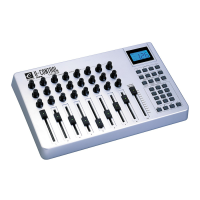12
RPN/NRPN’s Explained
Non-registered parameter numbers (NRPN’s) are device specific messages that enable the control of synths via MIDI. The MIDI specification defines
parameter numbers to allow scope for manufacturers to specify their own controllers. The more common of these have been registered by the MIDI
Manufacturer’s Association and are part of the MIDI specification (hence the term Registered Parameter Numbers – RPN’s). (See Appendix F.)
MIDI controllers 98 and 99 represent the NRPN LSB and MSB respectively, while 100 and 101 represent the RPN LSB and MSB. This can be seen from
the MIDI controllers list in Appendix D. To transmit an NRPN/RPN, these two controller messages are sent along with their user-specified values. A
further controller message and value needs to be sent to specify the (coarse or fine) value adjustment. This is specified by controller number 6 (Data
entry) for coarse adjustments or number 38 for fine adjustments.
A list of NRPN’s will always be given in the User Manual of a device that receives NRPN messages. It is always necessary that the NRPN MSB and LSB
are sent together. Both will be specified in the device’s manual. You may find the manufacturer’s have only specified the numbers in Hexadecimal format.
In this case, use Appendix C to translate the value to Decimal.
The UC-33 makes the process of transmitting NRPN’s easy. All you need is to enter the appropriate NRPN LSB by pressing the LSB/DATA button twice,
enter the NRPN MSB by pressing the MSB/DATA button twice, and as you move the UC-33 controller, an appropriate NRPN message will be sent out.
Assign NRPN coarse to make big sweeps, or NRPN fine to make slight adjustments.
SysEx Explained
System Exclusive (SysEx) messages were defined in the MIDI specification to allow individual devices to have individual control via MIDI. The format
of SysEx messages allows for virtually any function to be performed via MIDI – so long as the receiving device is able to translate the message, and act
accordingly. This allows devices to send audio sample memory data, memory dumps, controller settings, and much more. It also allows the controllers
of one device to be controlled by another.
It is not possible to program your own specified SysEx message into the UC-33. However, there are some useful SysEx messages pre-programmed into
the UC-33, that can be accessed by assigning the appropriate MIDI CC to a controller (see Appendix B).
It should be noted that a SysEx message is not transmitted on any specified channel. All SysEx messages contain a device ID, that is used to single out
devices to respond to the SysEx message. All other devices are ignored. If you are using a SysEx message on the UC-33, the global channel is ignored.
When you press CHANNEL, instead of entering a channel for the controller, you will be enter a device ID instead. This is indicated by the fact that the
CC symbol will not be showing.
Device ID’s run from 00 to 127. 127 is the default device number setting on the UC-33. This setting transmits the SysEx message to all devices. Although
it is not possible to program the controllers of the UC-33 with your own SysEx messages, there are software applications that can receive a MIDI input
signal and transmit a different, user specified message. You can program your SysEx messages into the translator software, then translate the incoming
data from the UC-33 to your SysEx, depending on the controller you are using.

